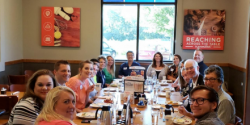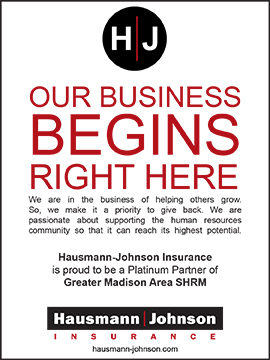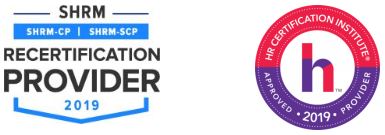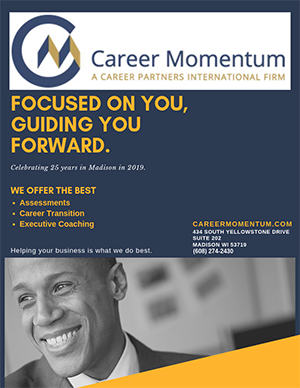September 2019 |
HR InTouchThe Monthly Newsletter of the Greater Madison Area SHRM |
||||||||||||||||||||||||||||||||||||||||||||||||||||||||||||
In This EditionPresident's Message Government Affairs & Legal Updates
Professional Development September PDS Topic: How to minimize biases during the interviewing process? Compensation and Benefits GMA SHRM Compensation Survey Coming Soon Considering Compensation Data Sources Workforce Readiness August 28th Dane County Regional Fair Was a Success! Diversity Community Investment at UW Health GMA SHRM Media Relations How to Write a Social Media Policy for Your Company (With Starter Template via SHRM)
September 17th Professional Development Summit - Session 1: Facing Unconscious Bias in the Hiring Process - Session 2: Building an Inclusive Workplace HR Advice Network Roundtables Recap: August 29th Meet, Eat & Greet a Great Success GMA SHRM Member News Spotlight: Human Capital Conference Committee Welcome New Members!
|
Greetings GMA SHRM Members – Government Affairs & Legal Updates What To Do When ICE Comes To Your Workplace
Submitted by Brenna McLaughlin at Boardman & Clark LLP and GMA SHRM Member of Programming Committee
September PDS Topic: How to minimize biases during the interviewing process?Submitted by September PDS presenting organization Step Up: Equity MattersI love watching The Voice. It’s truly uplifting.
Compensation and Benefits
Participation is now closed, data is being analyzed and the survey will be available for purchase soon! Participant pricing is $300 and Non-Participant pricing is $600. |
||||||||||||||||||||||||||||||||||||||||||||||||||||||||||||
| East Herzing University 5218 East Terrace Drive |
South Central Effective August, new location: NeuGen, 45 Nob Hill Road Previous location: The Alliance 5510 Nobel Drive, 2nd floor |
West Accuray 1 Erdman Place |
|
|
|
Recap: August 29th Meet, Eat & Greet a Great Success
Thanks to our Volunteer Engagement Committee for coordinating another great Meet, Eat & Greet at IHOP 8/29 in Middleton! Stay tune for more upcoming opportunities to join in on this recurring event. Come join and share stories, interests and have some laughs with some good food, in a less structured relaxed environment.
 |
 |
 |
GMA SHRM Member News
Spotlight: Human Capital Conference
Submitted by Dana Denny, Compensation Analyst at WI State Courts and GMA SHRM Director of Human Capital Conference
Have you attended previous Human Capital Conferences at the Alliant Center in Madison, WI and wondered how GMA SHRM is able to select such fantastic keynote speakers, maintain excellent, yet practical breakout sessions, and continue to provide programming options with content you’ve come to expect from national conferences yet have the opportunity to attend in your own backyard? Well, creativity and imagination are trademarks of our GMA SHRM Human Capital Conference (HCC) Committee volunteers!
The GMA SHRM Annual Human Capital Conference (HCC) offers meeting attendees relevant human resource content on issues including compensation, government affairs, innovative recruiting techniques, and employee engagement in an entertaining atmosphere that’s conducive for networking. Although the HCC is held in the spring of each year, planning for this event begins the previous August with the selection of the conference date and a slate of speakers. We are pleased to announce next year’s HCC will be held at the Alliant Energy Center on Tuesday, May 19, 2020, so mark your calendars!
Although we have just begun our planning efforts for next year’s Conference, we are always looking to add to our group of intrepid and wonderful volunteers! If you’d like to learn more about this committee and how you might benefit from volunteering for the GMA SHRM Human Capital Conference, please feel free to email me at dana_denny@hotmail.com with any questions.
Return to Top
Welcome New Members!
GMA SHRM welcomes the following members who joined our chapter in July 2019!
| Casey | Alderman | Smart Motors INC | |
| Joey | Backus | Cottingham & Butler | |
| Theresa | Breunig | SHRM-CP | Guardian |
| Marvel | Browne | UW Health | |
| Tom | Fox | Connect Search, LLC | |
| Danae | Junakin | Madison Gas & Electric | |
| Lance | Lattimer | Fujifilm Cellular Dynamics | |
| Paige | Neumeyer | Concero Search Partners | |
| Gary | Oetzman | Reach Dane | |
| Austin | Pellissier | Connect Search | |
| DulcyAnn | Smith | Smart Motors | |
| Olivia | Stoffels | WPS Health Solutions |
Movin' Up
Have you started with a new company? Has your organization recently promoted you to a new position? Or do you want to recognize a new person or promotion within your department? If so, we want to hear about it. Send us an e-mail, and we’ll publish your good news in the next HR InTouch!
In Transition
If you are a member who is in between jobs, or who is currently employed but seeking new positions or career paths, write us a brief description of your skill set, areas of expertise, what you’re looking for, etc. Send us an e-mail. We’ll publish your information in the next HR InTouch.
HR InTouch Guidelines
Article Writing:
Do you have an interest in writing for the HR InTouch? We have an interest in learning more about your area of expertise!
Why should you volunteer? Top three reasons: 1) to share your knowledge and experiences to educate others; 2) to become more connected in the HR and Dane County communities; and 3) to contribute towards the advancement of GMA SHRM and the HR profession.
The first step is for you to choose a submission option: you can pre-submit an article to GMA SHRM at any time for us to use in any of the upcoming newsletters, you can sign up to write for a particular month, or we can put you on a list of people to contact in future months whenever we need articles.
Article length:
Because the HR InTouch is now in an online format, the size is flexible. The article should be engaging and hold readers’ attention. Include the core information in your article, and we will advise if it is too lengthy.
Solicitation:
GMA SHRM is conscious not to allow solicitation through the articles, in an effort to protect the interests of our partners and members. The nature of the article should be educational (i.e., what are the business advantages of having a product like yours) or informational. Otherwise, if you truly are interested in advertising through the HR InTouch, you can work with our Marketing Committee. As a rule of thumb for article writing, if the submission relates to a for-profit event, or specifically markets your company (vs. your industry), it is an advertisement, and should be purchased. If it is a not-for-profit event that your company is hosting, or an announcement (i.e., a SHRM member recently joined your company), it is an acceptable addition to the HR InTouch content. If you have any questions related to the appropriateness of your submission, please contact us.
If you have questions, or to submit an article, contact GMA SHRM at chapteradmin@gmashrm.org .




A_SHRM%20Experience%20Gaurantee%20Ad.jpg)
 August 28th Dane County Regional Fair Was a Success!
August 28th Dane County Regional Fair Was a Success!  “I find it so gratifying to help local job seekers who just need that extra push to go after what they want. Having a mini-coaching session to help them build confidence is sometimes all they need, especially after many “rejections.” I’ve gained a lot of knowledge and experience within recruitment my past few years in HR and being able to share that side to the job seeker makes me feel fulfilled and joyful.” – Mary Moua
“I find it so gratifying to help local job seekers who just need that extra push to go after what they want. Having a mini-coaching session to help them build confidence is sometimes all they need, especially after many “rejections.” I’ve gained a lot of knowledge and experience within recruitment my past few years in HR and being able to share that side to the job seeker makes me feel fulfilled and joyful.” – Mary Moua The Workforce Readiness Committee is always seeking volunteers and new committee members to join! This is a great way for HR Professionals to have fun, engage, share knowledge, and offer advice to our local job seekers. What better way to give back to our community than to share what you’ve learned on the HR side with job seekers who simply want feedback or guidance on what recruiters/hiring managers typically look for.
The Workforce Readiness Committee is always seeking volunteers and new committee members to join! This is a great way for HR Professionals to have fun, engage, share knowledge, and offer advice to our local job seekers. What better way to give back to our community than to share what you’ve learned on the HR side with job seekers who simply want feedback or guidance on what recruiters/hiring managers typically look for. Newsletter Coordinator: Mary Moua, Employee Engagement & Social Media Specialist at Fairway Independent Mortgage Corporation
Newsletter Coordinator: Mary Moua, Employee Engagement & Social Media Specialist at Fairway Independent Mortgage Corporation